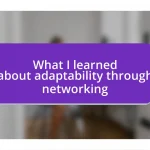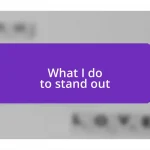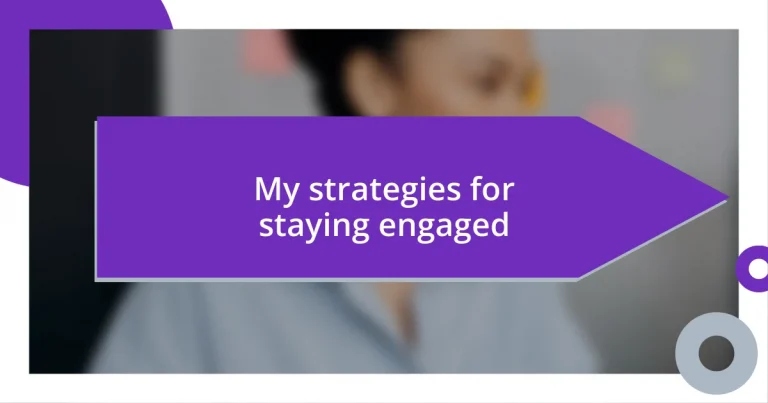Key takeaways:
- Engagement strategies such as personal storytelling and feedback loops foster deeper connections and participation within a team.
- Staying engaged boosts motivation, enhances information retention, and cultivates a sense of community among individuals.
- Creating a supportive environment and regularly evaluating strategies can significantly improve focus, productivity, and overall engagement.
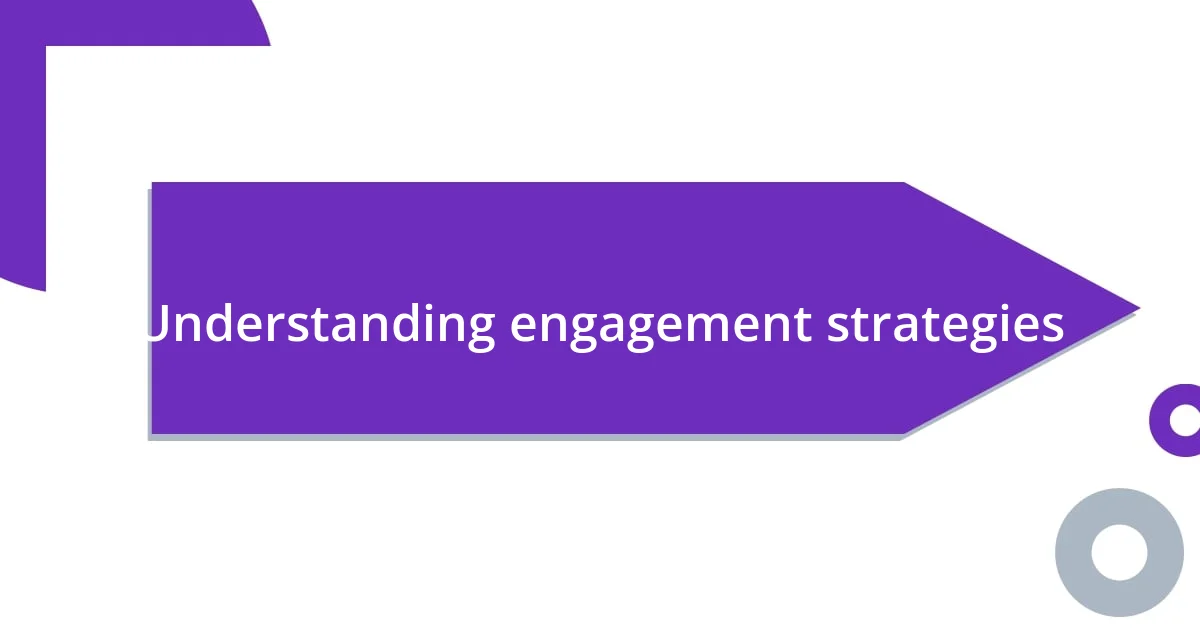
Understanding engagement strategies
Engagement strategies revolve around actively connecting with your audience, whether it’s in a classroom, at work, or in a digital environment. I remember a time when I introduced interactive polls during team meetings. The shift was palpable—people became lively contributors instead of passive listeners. It made me wonder, how often do we overlook the power of involvement?
One effective strategy is personal storytelling. I once shared a narrative about a tough project I managed, and the room changed instantly. It sparked discussion, and others felt comfortable sharing their experiences. What is it about vulnerability in storytelling that resonates so deeply with others? I believe it’s the shared human experience that creates a bond, making it vital for fostering engagement.
Lastly, feedback loops are crucial in sustaining engagement. I frequently ask for input after implementing changes to my workflow. It feels rewarding when team members share their thoughts—it validates their importance. I often ask myself: are we truly creating a space where everyone feels heard? When individuals see their voices matter, it amplifies their connection to the team and encourages ongoing participation.
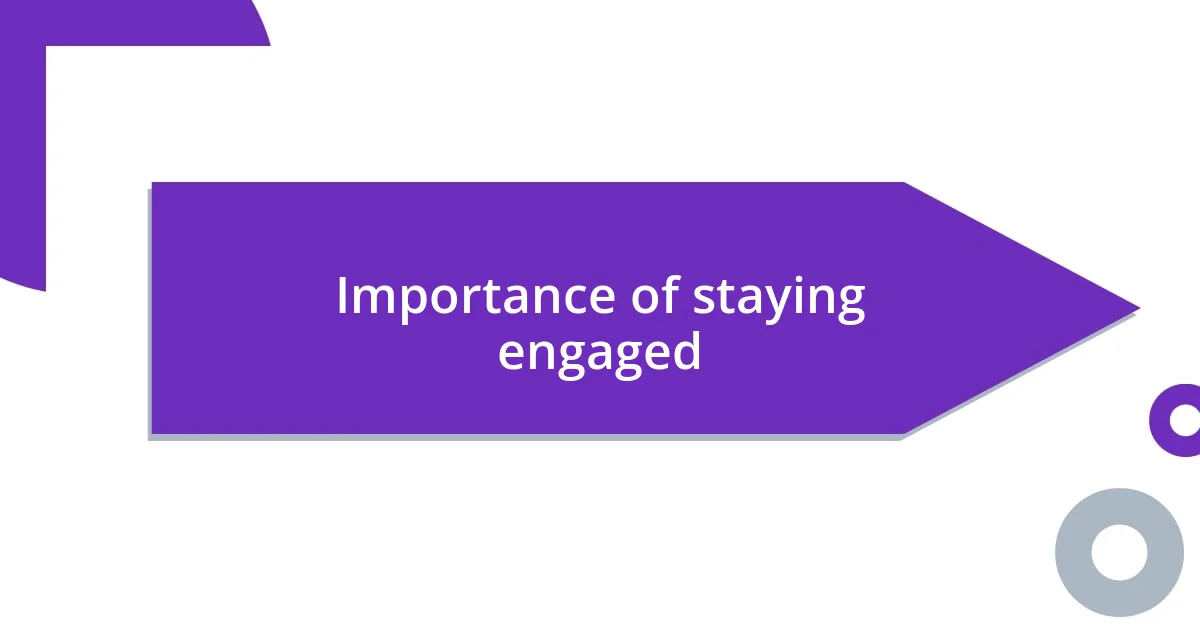
Importance of staying engaged
Staying engaged is incredibly important because it fuels motivation. I recall a time when I felt disconnected during a project. My results suffered until I made a conscious effort to reengage with my team. It struck me that enthusiasm is contagious; when one person lights up, it inspires others.
Additionally, remaining engaged enhances retention of information. I’ve noticed that when I’m actively involved in discussions or activities, the details stick with me longer. It’s a bit like learning a new language—immersion significantly boosts proficiency. I often reflect on how I remember more from conversations where I was participating compared to those where I simply listened.
Finally, engagement fosters a sense of community. In my experience, when individuals are involved, they genuinely invest in the success of their peers. I think back to a volunteer project where the spirit of collaboration turned a mundane task into a meaningful experience. The energy and shared purpose we created made all the difference.
| Benefits of Staying Engaged | Consequences of Disengagement |
|---|---|
| Boosts motivation and enthusiasm | Leads to decreased productivity |
| Improves retention of information | Results in poor comprehension |
| Nurtures a sense of community | Creates feelings of isolation |
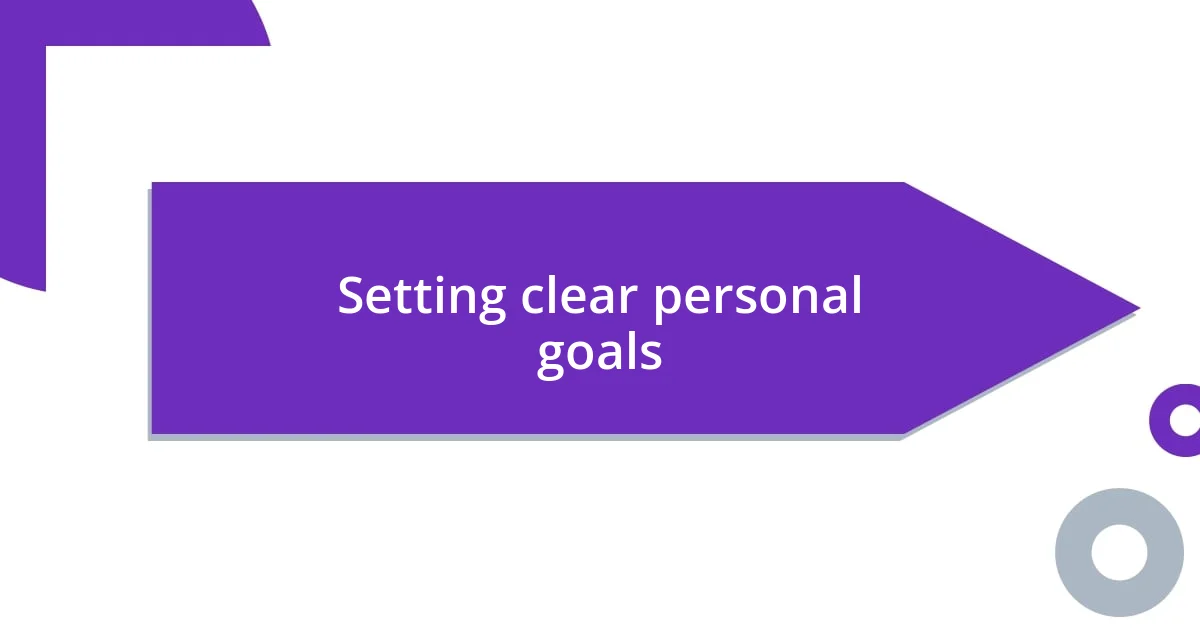
Setting clear personal goals
Setting clear personal goals is a crucial step in staying engaged. I tend to think of my goals as my personal compass, guiding me toward what I truly want to achieve. For instance, I once set a goal to learn a new skill every month. This not only kept my enthusiasm bubbling but also gave me tangible milestones to look forward to. The satisfaction that washed over me when I completed a challenging course was truly invigorating.
- I start by identifying what truly matters to me—what sparks my passion.
- Next, I break those down into smaller, actionable steps that feel manageable.
- I make it a point to revisit my goals regularly to adjust them based on my evolving interests and circumstances.
- Celebrating those small milestones along the way keeps me fueled and focused, creating a rewarding cycle of engagement.
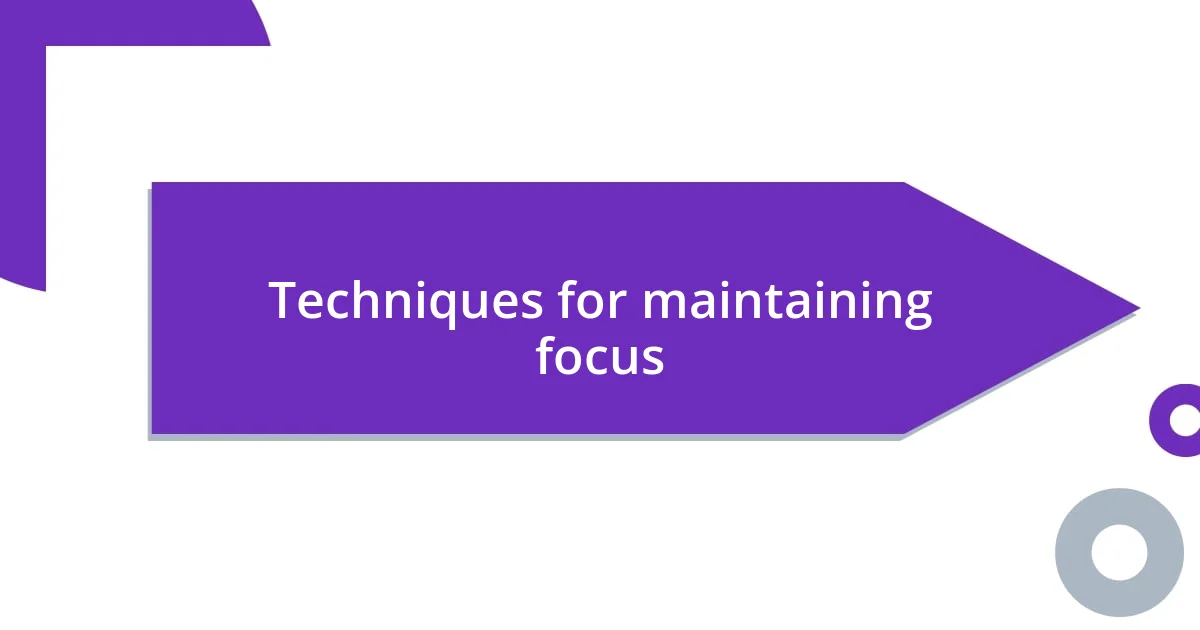
Techniques for maintaining focus
Maintaining focus can sometimes feel like an uphill battle, especially with endless distractions around us. One technique that I find incredibly helpful is the Pomodoro Technique. I set a timer for 25 minutes and dive into my tasks without interruptions, followed by a 5-minute break. This structured approach not only helps me stay on task but also makes each work session feel less daunting—like I’m in a sprint, which often ignites my concentration.
Another strategy involves creating a distraction-free environment. I remember when I began working from home; I had to establish boundaries to keep myself focused. Putting my phone on silent and using noise-cancelling headphones transformed my productivity. Have you ever noticed how a cluttered space can cloud your mind? Tidying up my workspace calmed my thoughts and made it easier to immerse myself in my work.
Finally, I believe in harnessing the power of mindfulness. When I feel my focus waning, I take a moment to perform a quick breathing exercise. Just pausing to breathe deeply for a minute can refresh my mind, offering clarity and renewed energy. Have you tried this? It’s striking how something so simple can have such a profound impact on our focus.
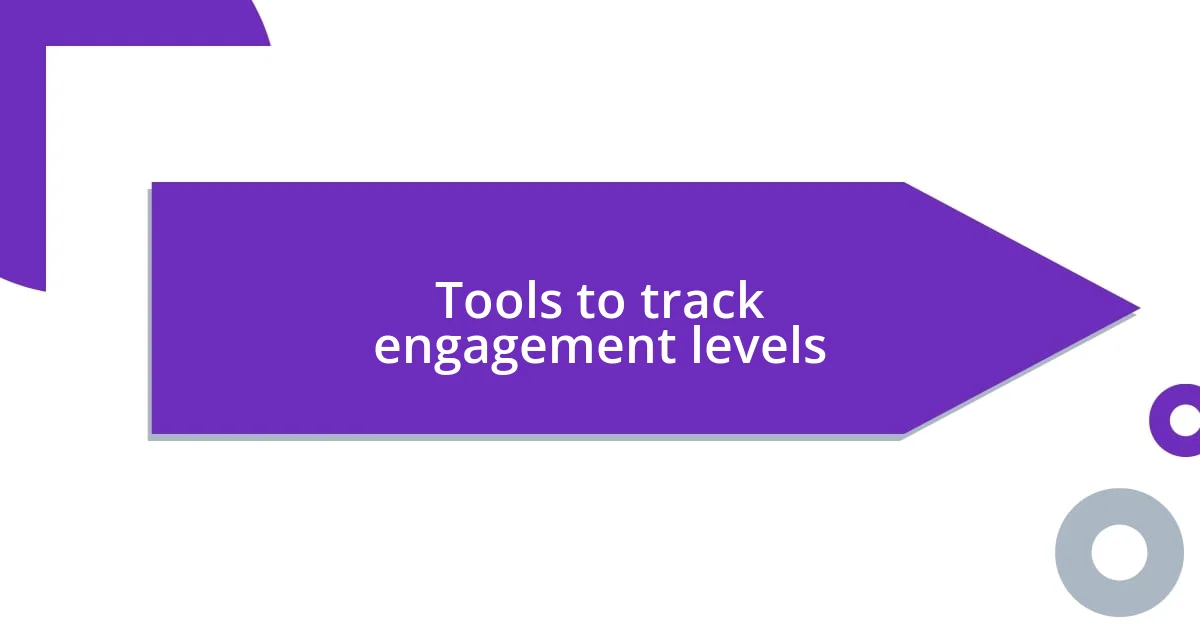
Tools to track engagement levels
Tracking engagement levels can be a game changer in understanding how effectively I’m connecting with my tasks or projects. One tool I absolutely love is a digital journaling app. It allows me to jot down how I feel about my work, the challenges I encounter, and the moments I’m most proud of. Have you ever tried tracking your mood alongside your productivity? It’s fascinating to see the correlation between my emotional highs and lows and my engagement levels.
Another approach I embrace is the use of analytics tools, especially for my online interactions. For instance, I frequently rely on Google Analytics to monitor engagement on my blog. Looking at metrics like bounce rates and time spent on a page provides me with valuable insights. It helps me ask questions like, “What content resonates most with my audience?” That information is crucial for adjusting my strategy and ensuring I’m staying connected with my readers.
I also keep an eye on social media engagement metrics. Platforms like Instagram and Facebook have built-in analytics that show me which posts generate the most interaction. I remember when I posted a behind-the-scenes video about my creative process, and the overwhelming responses surprised me. It made me realize that my audience craved authenticity and connection. These tools not only measure engagement but also inspire me to create more meaningful content that truly resonates. Have you found any engagement-tracking tools that work wonders for you?
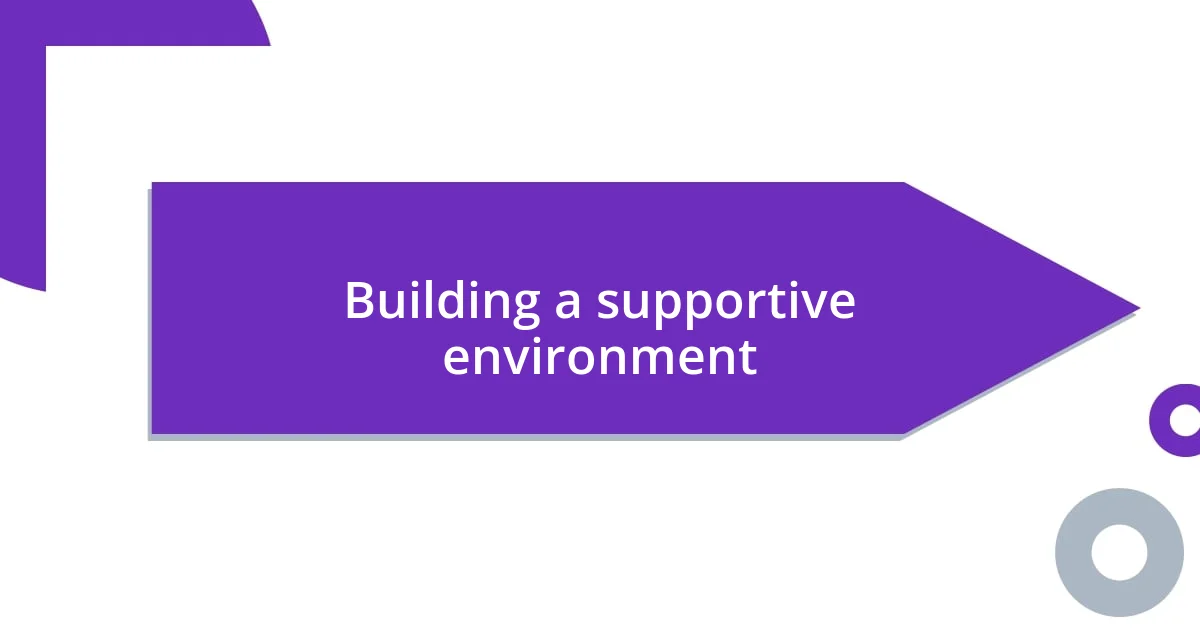
Building a supportive environment
Creating a supportive environment is crucial for maintaining engagement. I vividly recall a time when I joined a coworking space to escape the isolation of working from home. The energy in the room was infectious, filled with like-minded individuals who were also pursuing their passions. Have you ever experienced that buzz of motivation from those around you? It’s amazing how sharing a space with motivated people can lift your own spirits and enhance your drive.
Moreover, I pay close attention to my social circle. Surrounding myself with individuals who lift me up rather than drain my energy has made a significant difference in my productivity. For instance, I made it a point to engage more with friends who understand my goals and aspirations. Their encouragement often serves as a gentle push on days when I feel stuck. Do you have a go-to person who sparks your creativity and focuses your thoughts? Finding that connection can be a game-changer in establishing a supportive environment.
I also find that setting up a positive workspace plays a vital role in keeping me engaged. Incorporating plants and artwork that inspire me creates a picturesque setting where I feel comfortable expressing my thoughts. One specific piece I hung up is a quote that reminds me of my values and dreams. Every time I glance at it, I feel a surge of motivation wash over me. Have you considered how your workspace affects your mood? Little tweaks can make all the difference in fostering a more supportive environment that fuels your drive.
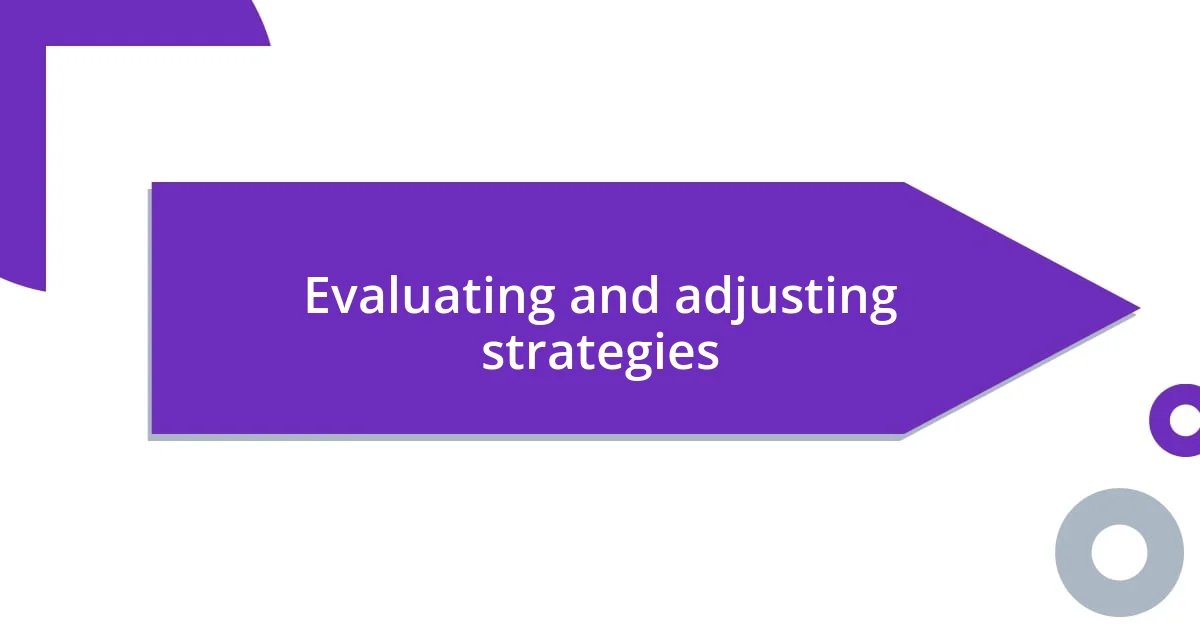
Evaluating and adjusting strategies
When it comes to evaluating and adjusting strategies, I often start by reflecting on what’s working and what’s not. One time, I noticed my excitement about a particular project was waning. After analyzing my approach, I realized I had fallen into a repetitive routine. This insight prompted me to mix things up, leading to a burst of creativity and renewed engagement. Have you ever re-examined your routine to discover hidden barriers?
Regularly seeking feedback is another key factor in ensuring my strategies remain effective. There have been instances where I reached out to trusted colleagues for their perspectives on my work. Their constructive criticism helped me identify blind spots I couldn’t see myself. This process not only enhances my work but also creates a collaborative environment where everyone feels valued. How often do you engage with others to refine your approach?
Adapting my strategies doesn’t just happen on a grand scale; I find that small tweaks often yield significant results. I remember a week when I started setting daily goals instead of weekly ones. This shift allowed me to celebrate smaller victories, which kept my motivation levels high throughout the day. Have you ever thought about how minor adjustments to your goals can transform your experience? It’s those little changes that can make a substantial impact on your overall engagement.


